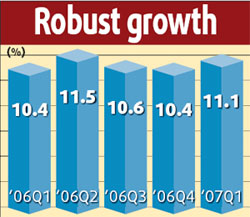| Home / Business / Healthcare & Pharmaceutical | Tools: Save | Print | E-mail | Most Read | Comment |
| Retail Chains Pose a Challenge to Smaller Pharma Companies |
| Adjust font size: |
As low-priced drug retail chains gain strong momentum in the pharmaceutical retailing, traditional retail formats are busy restructuring themselves. The consequence is the emergence of strong retail outlets in first- and second-tier cities. This is a challenge to small- and medium-sized pharmaceutical companies. They must take active measures to form effective cooperation with retail channels and grow with their help in market expansion and company development. But along with cooperation, smaller drugmakers must also have their own principles: Equality Smaller firms are weak compared with big retail channels, but they should not look down upon themselves, instead should base cooperation with retail chains on equality and mutual benefits. If they think they are weak and should rely on strong distribution channel partners, it will put them in a passive position, resulting in continuous concessions to their partners. Strategic partnership Smaller firms should try to build long-term and strategic cooperation. Retail channels are important to drugmakers, but the sector differs from traditional distributors or wholesalers because retail outlets are the contact point with patients and customers, requiring more careful planning and management of the network. Dynamic management Small and medium pharmaceutical businesses should put strong retail channels into their own management, centered around market changes. They also need to evaluate risks and learn market trends and consumer demands through retailers to provide data for other operations and new products. Smaller businesses can use the following techniques to deal with power retail chains: Product supply: Weaker drugmakers should have special supplies for retail chains to take advantage of their strength in products and product packages. In packaging, products sent to retail chains should be of a smaller size than those sent to other outlets to meet their needs or faster product cycles. In products, businesses should analyze patients' demands and provide the appropriate medicines. At the same time, companies should also have a supply technique to keep the product cycle for retailers short. Pricing: This is a key link in dealing with large retail chains. The pricing scheme must be different and based on a comprehensive analysis of patients' affordability, competitive products, dosage, supply price and retail price. The prices should be a little bit lower than products going through other channels. At the same time, they should regulate prices through contracts and incentives to keep the whole price system stable. Close watch on outlets: It is meaningless if a drugmaker just moves its inventory into a warehouse of a retailer. Retail outlets need a close watch. At present, advertising medicines is still highly regulated, so a retail outlet can be a good platform to educate patients and spread brand names. So pharmaceutical firms should use methods like attractive posters, packages and innovative layouts to promote retail sales and communicate with patients. A balanced channel: Large retail chains are just part of the market and it is dangerous to put all resources into them. The complexity of the Chinese market determines traditional distributors - individual distributors and wholesalers - will remain in the market and they play a meaningful role in expanding coverage and sharing risks. Smaller companies should continue to train and support traditional distributors to build cooperation in community clinics in the future to avoid the risk of over-reliance on one type of outlet. They should also consolidate their traditional distributors and ask them to be responsible in promoting sales in retail chains to transform their business model from making profits through wholesale to revenue sharing. Brand is key: Brand is a key bargaining chip with strong retail chains. Brands mean endorsement from patients and customers, which drive sales for retailers, so drugmakers can pay lower entry or display fees and get payments quicker. Without a solid brand, pharmaceutical companies usually put themselves in a passive position in the bargaining with powerful retailers. Of course, smaller businesses do not have as many resources and have difficulties in building brands, but they can concentrate in a regional market and make good preparations for product positioning and identification so that customers can easily pick them out. (China Daily July 12 2007) |
| Tools: Save | Print | E-mail | Most Read |
| Comment |
 |
| Related Stories |
|
